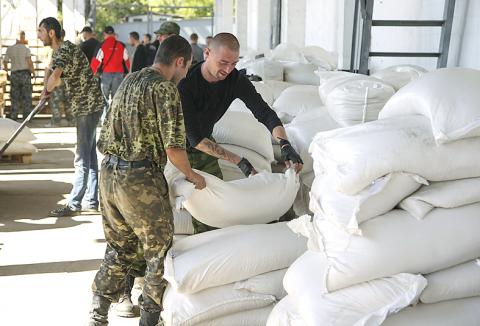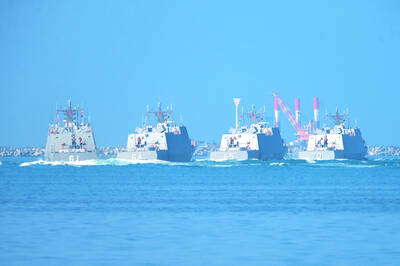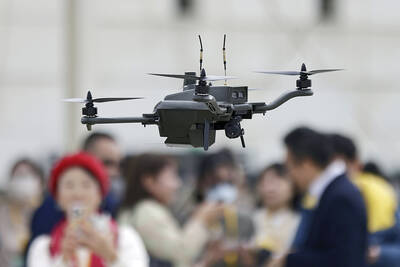Ukrainian forces and pro-Russian militias were due yesterday to pull back their troops from a demilitarized zone created under a new peace plan agreed in marathon overnight talks.
A nine-point agreement thrashed out in the early hours yesterday in the Belarussian capital, Minsk, also requires the withdrawal of all “mercenaries” from the conflict zone and an immediate end to hostilities.
However, Russia appeared ready to keep up the pressure on its Westward-leaning neighbor by sending in a new 30-truck convoy it said was carrying aid for the rebel-held city of Donetsk, but that Ukraine never approved.

Photo: EPA
Former Ukrainian president Leonid Kuchma — who is representing Kiev in the stuttering efforts to resolve the five-month conflict — said the agreement rested on the creation of a 30km buffer zone.
Forces from both sides are required to retreat 15km from current frontlines within 24 hours of the signing of the accord and allow monitors from the Organization for Security and Co-operation in Europe into the area to make sure the truce holds.
The areas under rebel control would be left open to their administration under a temporary self-rule plan adopted by lawmakers in Kiev on Tuesday.
The Minsk pact — also signed by Moscow’s ambassador to Kiev and the self-proclaimed “prime ministers” of the rebel-run regions of Donetsk and Lugansk — aims to shore up a ceasefire deal agreed two weeks ago.
The agreement crucially requires both sides to immediately withdraw “foreign mercenaries” from the conflict zone in industrial eastern Ukraine.
Kiev and Western allies accuse Russia of clandestinely slipping at least 1,000 paratroopers into eastern Ukraine to help the guerrillas mount a surprise counteroffensive late last month.
The Kremlin denies ordering soldiers into Ukraine. However, Moscow’s Kiev envoy Mikhail Zurabov told Russian media after the signing of the Minsk deal that both sides appeared to have hired foreign mercenaries.
The sides agreed to leave the most divisive political issues for future negotiation in order to get the terms of the truce worked out first.
Donetsk separatist leader Alexander Zakharchenko said that the explosive question of the status of rebel-held Donetsk and Lugansk was not discussed in Minsk by mutual consent.
“We each have our own understanding of [Kiev’s] law on special status,” Russian media quoted Zakharchenko as saying.
“These are issues for future negotiations that will last another year,” he added.
The elusive ultimate goal is to find a lasting solution to a conflict that has claimed nearly 3,000 lives and stoked Western alarm about Russia’s territorial ambitions.
The talks came in the wake of a peace overture by Ukrainian President Petro Poroshenko that included a limited self-rule offer for separatist-controled areas in the east and an amnesty for all fighters.
The ceasefire has helped calm the worst fighting, but continues to be regularly broken around Donetsk — the scene of almost daily shelling on the city’s outskirts — and other disputed parts of the Russian-speaking industrial heartland.
Rebel representatives in the city of nearly 1 million — now with neighborhoods abandoned by families devastated by constant shelling and food shortages — said they had received a Russian humanitarian convoy overnight.
The press service of the self-proclaimed Donetsk People’s Republic said the volume of aid “was very large,” but provided few other details.
Ukraine was still set to receive an important boost from the 28-member NATO military alliance when its defense chiefs gathered yesterday in the Lithuanian capital Vilnius for a three-day meeting.

FOUR DESIGNATED AREAS: Notices were issued for live-fire exercises in waters south and northwest of Penghu, northeast of Keelung and west of Kaohsiung, they said The military is planning three major annual exercises across the army, navy and air force this month, with the navy’s “Hai Chiang” (海強, “Sea Strong”) drills running from today through Friday, the Ministry of National Defense said yesterday. The Hai Chiang exercise, which is to take place in waters surrounding Taiwan, would feature P-3C Orion maritime patrol aircraft and S-70C anti-submarine helicopters, the ministry said, adding that the drills aim to bolster the nation’s offshore defensive capabilities. China has intensified military and psychological pressure against Taiwan, repeatedly sending warplanes and vessels into areas near the nation’s air defense identification zone and across

FORCED LABOR: A US court listed three Taiwanese and nine firms based in Taiwan in its indictment, with eight of the companies registered at the same address Nine companies registered in Taiwan, as well as three Taiwanese, on Tuesday were named by the US Department of the Treasury’s Office of Foreign Assets Control (OFAC) as Specially Designated Nationals (SDNs) as a result of a US federal court indictment. The indictment unsealed at the federal court in Brooklyn, New York, said that Chen Zhi (陳志), a dual Cambodian-British national, is being indicted for fraud conspiracy, money laundering and overseeing Prince Holding Group’s forced-labor scam camps in Cambodia. At its peak, the company allegedly made US$30 million per day, court documents showed. The US government has seized Chen’s noncustodial wallet, which contains

SUPPLY CHAIN: Taiwan’s advantages in the drone industry include rapid production capacity that is independent of Chinese-made parts, the economic ministry said The Executive Yuan yesterday approved plans to invest NT$44.2 billion (US$1.44 billion) into domestic production of uncrewed aerial vehicles over the next six years, bringing Taiwan’s output value to more than NT$40 billion by 2030 and making the nation Asia’s democratic hub for the drone supply chain. The proposed budget has NT$33.8 billion in new allocations and NT$10.43 billion in existing funds, the Ministry of Economic Affairs said. Under the new development program, the public sector would purchase nearly 100,000 drones, of which 50,898 would be for civil and government use, while 48,750 would be for national defense, it said. The Ministry of

SENATE RECOMMENDATION: The National Defense Authorization Act encourages the US secretary of defense to invite Taiwan’s navy to participate in the exercises in Hawaii The US Senate on Thursday last week passed the National Defense Authorization Act (NDAA) for Fiscal Year 2026, which strongly encourages the US secretary of defense to invite Taiwan’s naval forces to participate in the Rim of the Pacific (RIMPAC) exercise, as well as allocating military aid of US$1 billion for Taiwan. The bill, which authorizes appropriations for the military activities of the US Department of Defense, military construction and other purposes, passed with 77 votes in support and 20 against. While the NDAA authorizes about US$925 billion of defense spending, the Central News Agency yesterday reported that an aide of US